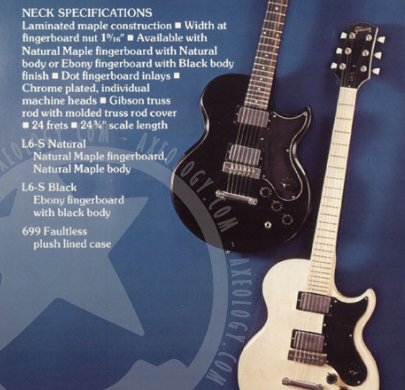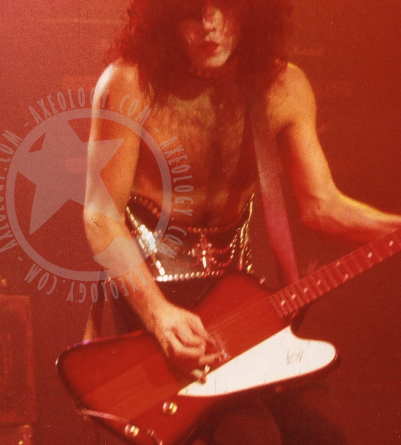
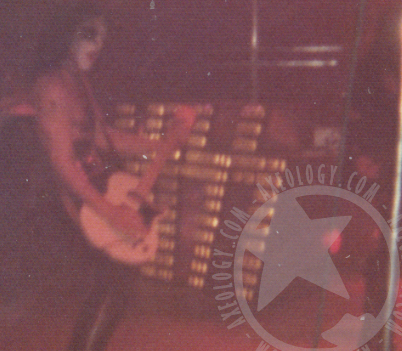
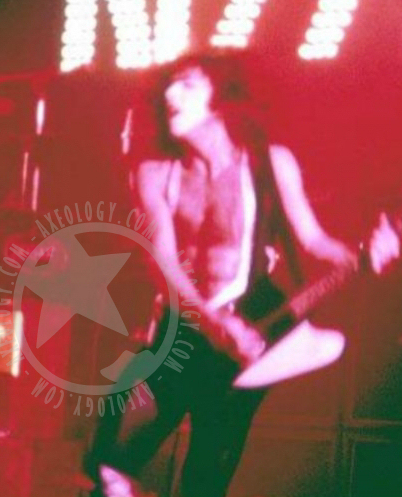
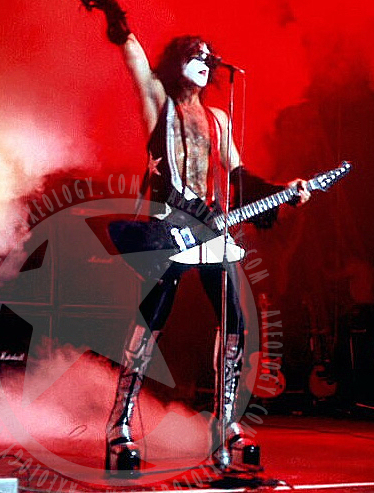
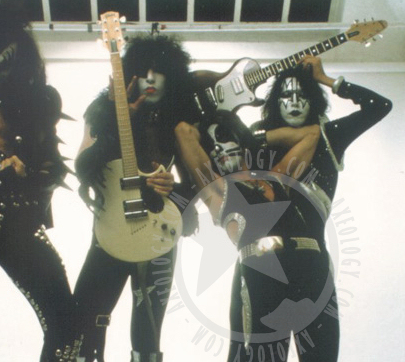
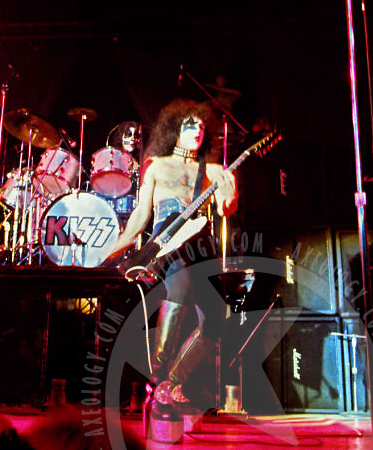
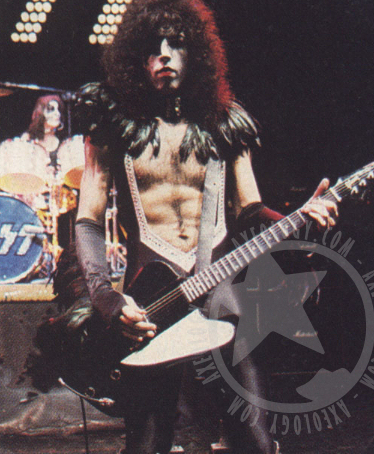


Some time in late 1974 Larry Davis of Casablanca pulled off a great deal for a relatively unknown band. "One of my projects was getting Gibson Guitars to sign KISS as an official sponsor. I'd successfully signed the band to a contract that provided them with free guitars in exchange for featuring the Gibson logo on all their albums and promising to use Gibson instruments exclusively on stage." (And Party Every Day, p. 100) When the deal was actually inked we don't know but Paul got his hand on a Gibson Midnight Special by December of 1974 (see pic) and Gene turns up with a Gibson Grabber around the same time so it was evidently finalized some time that fall. The classic "KISS plays..." text first appears on Dressed to kill upon its release in March of 1975.
The Midnight Special was the "bastard sibling" of the heavily advertised L6-S guitars designed by Bill Lawrence. I say "bastard" because it was never featured in the Gibson catalog, it was never advertised and, most suprisingly, it wasn't even listed in the price list. It was, by any measure, a "secret" guitar. In 1975 The Midnight Special first appeared in white, the only way the finish is ever mentioned, but Paul remembers his guitar as being slightly more extravagant: "Gibson was giving me these guitars, and they were called Midnight Specials, they had this weird white sparkle metal-flake finish and a bolt-on neck. They were free and sounded pretty good." (Guitars that Rule the World in Metal Edge presents KISS Alive, 1996) Only 161 white finish Midnight Specials were produced by Gibson 1975-77.
Design-wise the Midnight Special was more or less a combination of it's "older brothers": it had the same Schaller Harmonica bridge, the pickguard from the Custom (minus the hole for the chickenhead knob), and the three-way switch and string-through-body tailpiece of the Deluxe. Where it irrevocably differed from both was that it had a bolt-on neck, a move designed by Gibson to produce an affordable instrument that could compete, but on their terms, with the lower-end Fender models. (See also Gene's Gibson Grabber.)
The first real evidence of the Midnight Special comes from pictures from Davenport, IA as seen above. (The photo in Ken Sharp's Nothin' to lose identified as being from St. Louis 74.11.07 is mislabeled and is actually from February 1975.)
The Midnight Special was the "bastard sibling" of the heavily advertised L6-S guitars designed by Bill Lawrence. I say "bastard" because it was never featured in the Gibson catalog, it was never advertised and, most suprisingly, it wasn't even listed in the price list. It was, by any measure, a "secret" guitar. In 1975 The Midnight Special first appeared in white, the only way the finish is ever mentioned, but Paul remembers his guitar as being slightly more extravagant: "Gibson was giving me these guitars, and they were called Midnight Specials, they had this weird white sparkle metal-flake finish and a bolt-on neck. They were free and sounded pretty good." (Guitars that Rule the World in Metal Edge presents KISS Alive, 1996) Only 161 white finish Midnight Specials were produced by Gibson 1975-77.
Design-wise the Midnight Special was more or less a combination of it's "older brothers": it had the same Schaller Harmonica bridge, the pickguard from the Custom (minus the hole for the chickenhead knob), and the three-way switch and string-through-body tailpiece of the Deluxe. Where it irrevocably differed from both was that it had a bolt-on neck, a move designed by Gibson to produce an affordable instrument that could compete, but on their terms, with the lower-end Fender models. (See also Gene's Gibson Grabber.)
The first real evidence of the Midnight Special comes from pictures from Davenport, IA as seen above. (The photo in Ken Sharp's Nothin' to lose identified as being from St. Louis 74.11.07 is mislabeled and is actually from February 1975.)


Throughout the better part of 1975 all the string-wielding members of KISS tried to honor the Gibson sponsorship deal. Ace seems to have fared fairly well but that's probably because he already had his modified Les Paul Deluxe as his no. 1 and pretty much just tried a few things here and there in the backup slot. (Curiously most of the things he pulled out weren't factory new Gibsons but rather heavily modified things, see the Les Paul Deluxe on the cover of Alive!, or pawn-shop finds like the Epiphone Coronet. Only the Les Paul Junior and the elusive blonde Les Paul he has been pictured with look like they may have been acquired via Gibson.) Gene certainly tried his best as his section reveals but in the end he succumbed to his custom LoBue. Paul, however, managed to stick to Gibsons almost exclusively for a long time and during the first five months of 1975 that meant that the Midnight Special and the Firebird I worked hard. Pictures are lacking that show the Firebird in use before April but it can be seen it all its glory in the live video from Winterland on January 31. Its disappearance from view until later might be explained by the fact that KISS did some on-and-off recording for Dressed to kill during the better part of February. As a later quote will attest, Paul used the Firebird I in the studio as late as 1976.
The Midnight Special shows up a lot though and in the picture to the left from Lethbridge in Alberta, Canada and the shot from the Beacon Theatre in New York below we get a good look at the bolt-on construction.
The Midnight Special shows up a lot though and in the picture to the left from Lethbridge in Alberta, Canada and the shot from the Beacon Theatre in New York below we get a good look at the bolt-on construction.

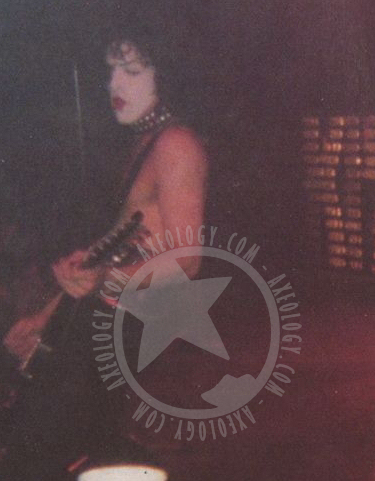

Before the year ran out Paul also managed to find one of his most beloved guitars, his Gibson Firebird I. It's not the greatest photo but even a poor picture of the headstock suffices; there were vanishingly few guitars with a reverse headstock in 1974. If the Midnight Special was the fruit of the new deal with Gibson, the Firebird I was added to Paul's stable of guitars in a more "traditional" way: "I picked up a reverse Firebird used somewhere. Another great guitar." (Guitars that Rule the World in Metal Edge presents KISS Alive, 1996) The fact of the matter is that even if Paul had wanted to he couldn't have gotten a Firebird I in this configuration from Gibson in 1974 unless he'd had it custom made.
The Firebird model was introduced by Gibson in 1963. It was a way to update the company's design while steering clear of the radical designs like the Explorer, on which the Firebird seems loosely based, which had failed miserably a few years earlier. The Firebird series were neck-through instruments with bodies and necks of mahogany and, in the case of Paul's Firebird I, Brazilian rosewood fretboard. (The top-of-the-line Firebird VII sported an ebony fretboard.) The initial run of these "reverse" Firebird, thus termed because of the then unusual feature of having the lower horn longer than the top, lasted only 1963-65 so Paul's guitar is from that period. The later Firebird which was produced 1966-67 (shipped until 1969) were "non-reverse" and had a different, larger pickguard and P90 soapbar pickups.
The Firebird model was introduced by Gibson in 1963. It was a way to update the company's design while steering clear of the radical designs like the Explorer, on which the Firebird seems loosely based, which had failed miserably a few years earlier. The Firebird series were neck-through instruments with bodies and necks of mahogany and, in the case of Paul's Firebird I, Brazilian rosewood fretboard. (The top-of-the-line Firebird VII sported an ebony fretboard.) The initial run of these "reverse" Firebird, thus termed because of the then unusual feature of having the lower horn longer than the top, lasted only 1963-65 so Paul's guitar is from that period. The later Firebird which was produced 1966-67 (shipped until 1969) were "non-reverse" and had a different, larger pickguard and P90 soapbar pickups.
The first proper look at the Firebird I comes from Detroit on December 20 and what we see is as close to factory original as possible: it's got the same wraparound bridge, the original humbucker with chrome cover, and the sunburst finish (which was the only one available for those 1963-65 models). The only change Paul made to the Firebird I at this time was that he possibly moved the strap button from its original position on the top edge near the neck to the back of the heel. This is a mod he frequently had done and even the Midnight Special got the treatment as can be seen in the January 7 pic below but in that instance his tech (presumably) just extended the upper right screw that attaches the neck and added a strap button to it. In the pic on the right you can also see the neck-through construction of the Firebird I via that clearly delineated and raised center section. (The lower edge of the neck-through section is in line with the upper edge of the pickguard.)

[Right] Despite having the relative luxury of getting instruments for free from Gibson this Firebird I was bought used even though it looks good as new.
After finishing the recordings for Dressed to kill the band continued their tireless touring but still found the time for a very high-profile TV appearance. On April 1 KISS recorded four songs for the NBC show The Midnight Special. Appropriately enough Paul played his Gibson Midnight Special for the occasion. The show wouldn't air until July 11 by which time the Midnight Special was almost a distant memory (see below).
April 13 saw the re-appearance of the Firebird I. It shows up in Kansas City and, lo and behold, it's black. "Originally wood finish, I thought it would look cool black. My dad managed an office furniture store and I took it [the Firebird] down there, and one of his guys painted it black." (Guitars that Rule the World in Metal Edge presents KISS Alive, 1996) At this time the knobs are also changed from the golden ones of the original to clear lucite knobs identical to those of the Midnight Special as can be seen in the Alive! photo shoot outtake below.
April 13 saw the re-appearance of the Firebird I. It shows up in Kansas City and, lo and behold, it's black. "Originally wood finish, I thought it would look cool black. My dad managed an office furniture store and I took it [the Firebird] down there, and one of his guys painted it black." (Guitars that Rule the World in Metal Edge presents KISS Alive, 1996) At this time the knobs are also changed from the golden ones of the original to clear lucite knobs identical to those of the Midnight Special as can be seen in the Alive! photo shoot outtake below.
[Right] Paul tearing it up and showing off his completely stock Gibson Midnight Special in New York.
[Left] The Firebird I's first appearance in the form that most KISS fans know it, re-painted black.
This re-finished version of the Firebird I is probably one of the better-known guitars that Paul has played thanks to it being featured on the cover of Alive!. (And while we're at it, the Alive! cover is probably one of the greatest advertisements that Gibson has ever managed. Not only does every member of the band proudly display their Gibson instruments, it even states explicitly on the back of the album that the band plays them.) The Alive! cover photo shoot also features the Midnight Special but by now its days are numbered. Its last known live appearance had been in Columbus on April 30 and after the Alive! shoot it only appears one more time, this time during the "white room" photo shoot on May 30. It is still part of the live guitar rotation, it shows up in a backstage pic of Gene warming up on his Gibson Ripper, a bass Gene didn't start playing until August of 1975, and it can be seen standing offstage as late as in Hempstead on August 23, but the Firebird is the undisputed no. 1 from May until the Flying V's enter the picture.



[Left] Alive! cover shoot outtake showing Paul with his Firebird I. "It really wasn't a very good paint job at all, but from a few rows back it looked great." (Guitars that Rule the World in Metal Edge Presents KISS Alive 1996)

[Right] The last hurrah of the Midnight Special. Also note Ace holding up the relatively new friend, the Gibson Marauder in the background.

With the no. 1 battle decided and the Firebird I coming out on top (presumably by a rather wide margin) touring continued as usual. Before moving on I must adress the possibility that Paul actually had the pickup in the Firebird I changed around the same time that it was refinished. The original 1963-65 pickup was never really specified by Gibson (the "reverse" Firebird model made its only appearance in the 1964 Gibson catalog where the pickup is simply referred to as a humbucker) but when viewed with modern eyes it appears to be smaller than a regular double-coil pickup. It also has a metal pickup ring rather than a plastic one. When the Firebird I reappears in its black guise the pickup ring is definitelty changed to a plastic black one and to my eyes the pickup itself looks a little bigger. I'm not comfortable stating this definitely, but as we've seen from the quotes and based on the later modifications to the Gibson Flying V's, it does seem probable. I've put together a comparison between the two versions of the Firebird I, roughly scaled to the same size, so that anyone can decide for themselves whether or not the pickup is different or not.
[Left] Paul plays to the crowd in Albany with the Firebird I. Note the backup Midnight Special standing off to the side.

[Below] The 1975 Gibson solid body catalog. No mention of the much cheaper Midnight Special.
[Above] Davenport, IA sees the debut of both the Firebird (see below) and the Midnight Special.
Towards the tail end of the Dressed to kill tour, picture evidence suggests some time in August, Paul started using Flying V's on stage. The Firebird I was still in use as can be seen from pics from Hempstead, NY on August 23, but once the Alive! tour starts in October the Flying V's pretty much take over. The last time it shows up before the new year seems to be in Chicago on November 22.
The Firebird I was part of the Destroyer sessions. Basic tracks for the album were first layed down in early September according to KISS Alive Forever!. Recording didn't resume until 1976, probably due to the runaway success of Alive! leading to that tour being re-scheduled and extended to capitalize on the success. (The 1976 European tour was originally slated for fall of 1975 but was pushed back to take advantage of the increase in concert attendance in the States.)
The Firebird I was part of the Destroyer sessions. Basic tracks for the album were first layed down in early September according to KISS Alive Forever!. Recording didn't resume until 1976, probably due to the runaway success of Alive! leading to that tour being re-scheduled and extended to capitalize on the success. (The 1976 European tour was originally slated for fall of 1975 but was pushed back to take advantage of the increase in concert attendance in the States.)


The final recording sessions for Destroyer took place in January of 1976 during a nicely planned break in touring (according to Corky Stasiak in Behind the Mask the sessions began on January 4). After a warmup show in Eerie, PA the band hit Detroit for the legendary three-night stand at Cobo Arena January 25-27. The Firebird I, however, doesn't seem to get any action until the tour came to Tulsa in March but it has lost its chrome pickup cover and shows a creme pickup. Alas, this is not Paul's beloved Firebird I but rather a replica.
"[H]ere we are in the control room playing the music back for Neil Bogart and company. Bob said, 'Let's do a vocal overdub, they need a pair of headphones'. To keep the headphone wire away from your arm when you play, you have to put the headphones through the strap of the guitar. So, not thinking, I grabbed the headphone wire and pulled it. Paul's headphones were still connected to [sic] the guitar strap, which was leaning against an Anvil case. When I yanked the cord, the guitar started to fall. As it was falling, I leaped across the studio to save it, and just missed catching it. I heard a loud 'Boiiing!' and knew exactly what had happened: the guitar had fallen over and the neck snapped in half at the nut. That was Paul's favorite guitar." (Corky Stasiak in Behind the Mask)
"I was in the studio doing Destroyer, and the engineer came in to me - he looked as white as a ghost - and he said, "Come into the studio for a minute." I came in, and my guitar was on the floor in two pieces. He had knocked it over. At that point, Gibson made me a handmade replacement, which was really nice, but it was never the same." (Guitar Player, 1978)
The mixing and mastering of Destroyer was finished on February 5 so the guitar Paul played in Tulsa and New Orleans (left) is the custom shop one he got from Gibson. This guitar could evidently not measure up to its precedent because it didn't last long. The Flying V's handled the main duties for the rest of the tour and after being brought on the European trip in May, where it only seems to have gotten used sparingly, the replacement Firebird I is retired.
"[H]ere we are in the control room playing the music back for Neil Bogart and company. Bob said, 'Let's do a vocal overdub, they need a pair of headphones'. To keep the headphone wire away from your arm when you play, you have to put the headphones through the strap of the guitar. So, not thinking, I grabbed the headphone wire and pulled it. Paul's headphones were still connected to [sic] the guitar strap, which was leaning against an Anvil case. When I yanked the cord, the guitar started to fall. As it was falling, I leaped across the studio to save it, and just missed catching it. I heard a loud 'Boiiing!' and knew exactly what had happened: the guitar had fallen over and the neck snapped in half at the nut. That was Paul's favorite guitar." (Corky Stasiak in Behind the Mask)
"I was in the studio doing Destroyer, and the engineer came in to me - he looked as white as a ghost - and he said, "Come into the studio for a minute." I came in, and my guitar was on the floor in two pieces. He had knocked it over. At that point, Gibson made me a handmade replacement, which was really nice, but it was never the same." (Guitar Player, 1978)
The mixing and mastering of Destroyer was finished on February 5 so the guitar Paul played in Tulsa and New Orleans (left) is the custom shop one he got from Gibson. This guitar could evidently not measure up to its precedent because it didn't last long. The Flying V's handled the main duties for the rest of the tour and after being brought on the European trip in May, where it only seems to have gotten used sparingly, the replacement Firebird I is retired.
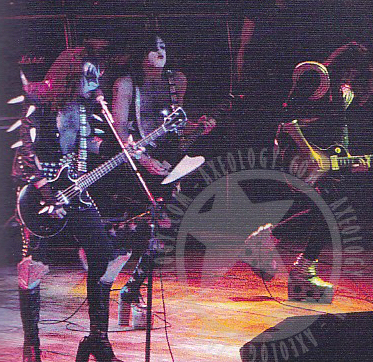



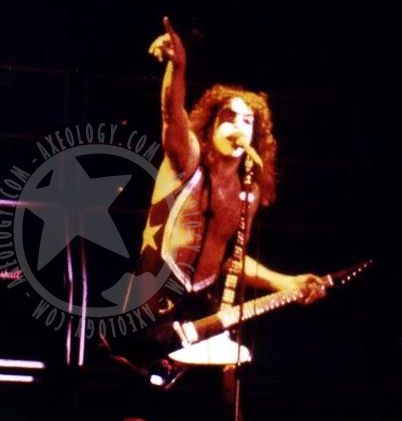
[Left] Trying to replace an old friend: the custom made Firebird I Gibson made after Paul's original met its demise during the Destroyer sessions.
[Right] The replacement Firebird I in Brimingham during one of its rare showings during the European tour.

"Gibson offered to make me a copy of [the Firebird I], which was pretty cool because at that point they hadn't been making them for God knows how long. They made me another one, but it was not a very good guitar. I used it but it didn't sound very good." (Guitars that Rule the World in Metal Edge presents KISS Alive 1996)
By 1976 the fast-growing level of fame brought with it a special perk, it was easier to find good guitars. Not only did the band suddenly have money to burn, people brought them guitars to buy. "When we would tour, the word was out that I was looking for guitars and people would be waiting at the backstage area when we would pull in with guitars cases." (Guitars that Rule the World in Metal Edge Presents KISS Alive 1996) The only problem could be that the prices sometimes got pushed a little high. Paul has claimed that he used the Gibson doubleneck EDS-1275 shown here while recording King of the Night Time World during the Destroyer sessions which means he bought it in January of 1976 at the latest. "The Gibson double-neck was from my guitar collection. It was a fairly rare 1967 factory Sunburst I got on the road for about $700 from a guy in Indiana who collected double-necks." (Guitars that Rule the World in Metal Edge Presents KISS Alive 1996) KISS made their way through Indiana twice during November and December of 1975 so perhaps that's when Paul bought this beauty. Whether or not it could be considered a "factory" guitar is a bit of a matter of opinion since the range of doublenecks Gibson offered in the late 60's were explicitly mentioned in the 1964 and '66 catalogs as being custom-built by the Gibson Custom Shop. Shown here on the left is said doubleneck during the filming of Hard Luck Woman for Don Kirschner's Rock Concert. Note the really long head of the 12-string neck.


The EDS-1275 disappeared from the Gibson catalog after 1966 and didn't return until 1978. But they were custom-built anyway so for the Winter Tour of 1976 Paul got himself a new doubleneck (presumably to not have to bring out his rare sunburst on the road). This one is black which was one of the available colors of the 1966 catalog listing of the EDS-1275 but it is definitely made in the 70's as we shall see in a minute. As was his wont there have been a few changes to the guitar from the get-go. The pickguard has been replaced with a mirror one and the bridge pickup for both necks have been replaced with his favored DiMarzios. Although it hardly qualifies as a modification it's interesting to note that the top neck, although actually a 12-string neck, looks to only have been strung with six strings.
For the Winter Tour the EDS-1275 didn't really get much action. It's not part of the show in Detroit, MI on January 29 and it doesn't show up in Feburary in New York either. KISS Alive Forever has Hard Luck Woman as part of the set for the show in New Orleans, LA on December 4 so that's most probably what the doubleneck was used for. Since we know that that particular song was played only a handful of times the doubleneck probably didn't see much action past December.
For the Winter Tour the EDS-1275 didn't really get much action. It's not part of the show in Detroit, MI on January 29 and it doesn't show up in Feburary in New York either. KISS Alive Forever has Hard Luck Woman as part of the set for the show in New Orleans, LA on December 4 so that's most probably what the doubleneck was used for. Since we know that that particular song was played only a handful of times the doubleneck probably didn't see much action past December.



[Right] The Gibson EDS-1275, probably during a rare performance of Hard Luck Woman in New Orleans, LA.
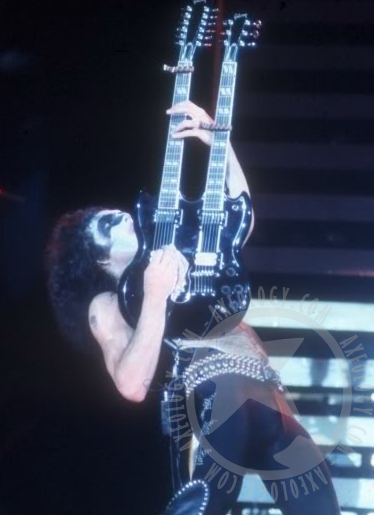
As mentioned in the Gibson Explorer section, once the band hit the road in support of Love Gun on the Can-Am Tour there were two songs in the setlist which required a capo: Hooligan and Makin' Love. For the first half of the tour the Gibson Explorer handled both duties and Pau's tech just moved the capo as there were more than a couple of songs between the two. Some time in August the setlist changed a little, the first confirmed setlist like this in KISS Alive Forever is from August 16, and the songs ended up closer to each other and then finally ending up being played back-to-back by late August. (First setlist in KISS Alive Forever that have the songs back-to-back is actually August 26 but based on the pic shown here I will assume that this change happened by August 22 at the latest.) This appears to be the same EDS-1275 that made a few brief appearances during the Winter Tour, still strung with only six strings on the top neck, but with a capo at the first fret on the top neck for Makin' love and a capo at the 7th fret on the bottom neck for Hooligan. A second pic from August 26 shows the same positions on the capos but this soon changed. For both shows in Houston in September the capos have switched places and there are a few pics, albeit of unknown date, that show the same thing.
The pic on the left also gives us good look at the headstock of the 12-string neck which tells us that this is undoubtedly a 70's EDS-1275. The 1966 catalog version, and the 1967 shown above, had individual full-size Kluson tuners with plastic tulip-style heads which necessitated the impossibly long headstock. Although I don't know for sure what year the move happened, by 1975 Gibson had moved to inline Gibson Deluxe tuners with oval heads which allowed for a much shorter head, the kind that's on Paul's EDS-1275 here.
Hooligan didn't stay in the setlist past the Can-Am Tour. When only one song required a capo there was no need for a doubleneck on stage and the black EDS-1275 was retired from stage duty.
The pic on the left also gives us good look at the headstock of the 12-string neck which tells us that this is undoubtedly a 70's EDS-1275. The 1966 catalog version, and the 1967 shown above, had individual full-size Kluson tuners with plastic tulip-style heads which necessitated the impossibly long headstock. Although I don't know for sure what year the move happened, by 1975 Gibson had moved to inline Gibson Deluxe tuners with oval heads which allowed for a much shorter head, the kind that's on Paul's EDS-1275 here.
Hooligan didn't stay in the setlist past the Can-Am Tour. When only one song required a capo there was no need for a doubleneck on stage and the black EDS-1275 was retired from stage duty.

[Above] A study in efficiency: two songs, two capos, one guitar. Paul in the middle of Makin' Love.
